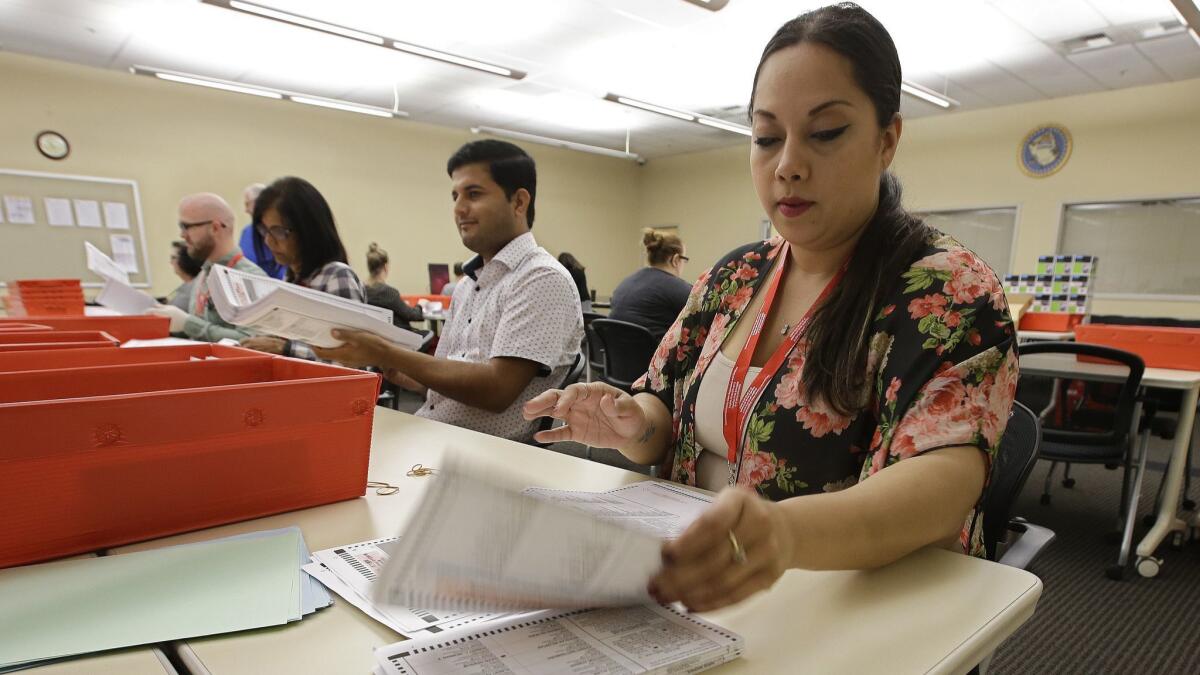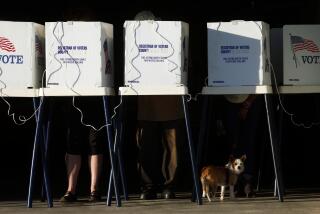Column: California’s ballots won’t all be counted next week, and that’s completely normal

- Share via
There is one safe prediction about this election week in California: The time it takes to count ballots will be criticized and lampooned as government at its worst, an unacceptable anachronism in a world that now expects instant results.
All of this will become great fodder for social media and talk radio alike. And it will be largely inaccurate.
The truth is that the existing system is based on a number of revisions made over the past two decades — all good-intentioned as ensuring accuracy or expanding voter access, but adding time to the mechanics of conducting an election.
Size matters, too. Even if turnout is lackluster — using historical standards, perhaps as few as 7 million of the state’s 19 million voters — it will be more ballots than elections officials in 48 states had to count in the last presidential election.
California’s electoral future is rooted in the old-fashioned absentee ballot »
And these are mostly votes cast on paper ballots. A number of California counties invested in touch-screen electronic machines in the early 2000s, but the state decertified the devices in 2007, citing security concerns. The resulting restrictions convinced most counties to limit their use.
Not that polling places matter as much as they used to. In 2002 only 26% of California’s ballots were cast absentee. By 2014, that had risen to 69%. Translation: Mistakes aren’t discovered until the envelope is opened at election headquarters in places like Norwalk for voters in Los Angeles County. State law is clear that a voter’s intent, even when a ballot’s stray marks or rips cause it to be rejected by a scanner, must be honored when possible.
Delays also happen when an absentee ballot envelope comes back without the voter’s signature. California voters have eight post-election days to show up in person at the county election office and fix it. Some counties are planning to extend the same right — following the recent ruling from a San Francisco judge — to a voter’s sloppy signature that can’t be matched to the one on file.
Other state laws also add time to the counting of votes. One says that ballots arriving by this coming Friday — if postmarked by election day — must be counted. Another says voters can turn in their ballot anywhere in the state. Those ballots have to get shipped back to the person’s county of residence, which will take time.
Voting by mail is poised to expand even further in 2020, when a new state law allows counties to close polling places and instead offer a limited number of “vote centers.”
Gov. Jerry Brown signs law allowing more absentee voting, fewer polling places »
It’s important to remember, too, that elections officials are required to perform post-election audits of tabulation machines and of a portion of the ballots counted by those devices. So add in more time.
That brings us to voters. Whether it’s a desire to hear more from a candidate or just procrastination, many wait until the eleventh hour to turn in their ballots. As of Friday, only 16% of the 11.6 million ballots mailed to Californians had been returned. Even if voters had turned them in earlier — say back in early May, for example — state law limits how early officials can begin to count ballots.
Still, the work proceeds relatively fast. Data from the last two California primaries show that at least 70% of the votes were counted by the weekend after election day. Absent radical change or significantly more taxpayer money — and counties often have been shortchanged by state lawmakers — California’s elections system can’t get much faster if it’s to produce accurate results. On election night and thereafter, patience is a virtue.
Follow @johnmyers on Twitter, sign up for our daily Essential Politics newsletter and listen to the weekly California Politics Podcast
More to Read
Get the L.A. Times Politics newsletter
Deeply reported insights into legislation, politics and policy from Sacramento, Washington and beyond. In your inbox three times per week.
You may occasionally receive promotional content from the Los Angeles Times.











